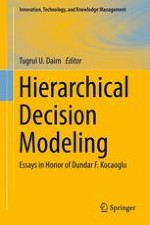2016 | OriginalPaper | Chapter
14. Decision-Making Tools: Deleting Criteria Using Sensitivity Analysis
Authors : Fatima M. Albar, Dundar F. Kocaoglu
Published in: Hierarchical Decision Modeling
Publisher: Springer International Publishing
Activate our intelligent search to find suitable subject content or patents.
Select sections of text to find matching patents with Artificial Intelligence. powered by
Select sections of text to find additional relevant content using AI-assisted search. powered by
